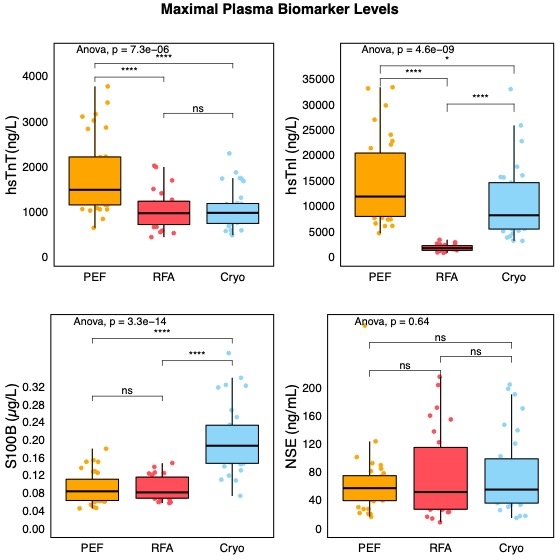BIOCHEMICAL MARKERS OF NEURO-MYOCARDIAL DAMAGE AFTER PULMONARY VEIN ISOLATION: THE EFFECT OF DIFFERENT ENERGY SOURCES
Background: Pulmonary vein isolation (PVI) by radiofrequency (RF) and cryoenergy(Cryo), is associated with a significant release of myocardial and collateral neural injury markers. Damage to periatrial ganglionated plexi also results in a substantial change in cardiac autonomic regulations. On the contrary, pulsed electric field (PEF) energy tends to spare cardiac neural tissue.
Objective: To quantify the impact of different ablation energy sources that are used for PVI on neuro-myocardial damage by the assessment of specific biomarkers.Methods: A study enrolled 85 patients with paroxysmal atrial fibrillation who underwent PVI (age: 61 ± 12 years, 74% males). In 23 patients, RF energy was delivered by the irrigated-tip catheter, while 30 patients were ablated using a cryoballoon catheter. In 32 patients, PVI was performed using a pentaspline catheter and PEF energy. Peripheral venous blood samples for assessing the plasmatic levels of S100, NSE, hsTnI and hsTnT were obtained before, immediately after the PVI, and the next day.
Results: Following PVI, a significant increase in plasma levels of all biomarkers was observed: hsTnT = 1040±434 ng/L, 1731±830 ng/L and 1010±397 ng/L; hsTnI = 1504±918 ng/L, 16464±11911 ng/L and 10789±7589 ng/L; S100B: 0.04±0.02 g/L, 0.03±0.04 g/L and 0.14±0.08 g/L; NSE: 34±72 ng/mL, 27±53 ng/mL and 45±52 ng/mL (all with P <0.001) for RF, PEF and Cryo groups, respectively. The hsTnT/S100B ratio was 23±14, 12±6, and 6±3 in PEF, RF, and Cryo groups, respectively (ANOVA P <0.01), indicating that PEF was 1.9-times and 3.8-times more cardioselective than RF and Cryo, respectively. Following the PVI, HR accelerated by 2±8, 13±14, and 9±11 bpm in the PEF, RF, and Cryo groups, respectively.
Conclusion: Compared to thermal energy sources, PEF energy induces more specific damage to cardiomyocytes than cardiac nerves.


